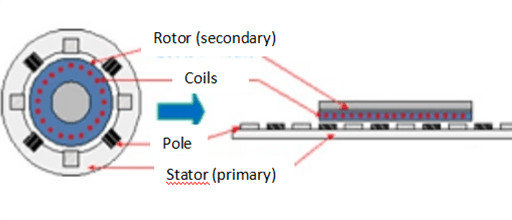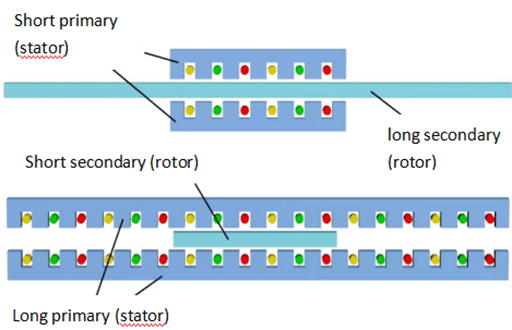
Figure 1: Three types of linear motors.
An electric motor is a device that converts electrical energy into mechanical energy, and the function of a linear motor is to convert electrical energy into mechanical energy for linear motion. In actual production, linear motion is required in many occasions, and it is often necessary to convert rotary motion into linear motion through necessary conversion devices, while linear motors can directly generate linear motion, which can simplify the conversion process of the equipment.
How Does a Linear Motor Work?
A linear motor is a transmission device that directly converts electrical energy into linear motion mechanical energy without any intermediate conversion mechanism. It can be regarded as a rotary motor which is cut radially and developed into a plane. The part corresponding to the stator of the rotary motor is called the primary, and the part corresponding to the rotor is called the secondary.
Take the linear induction motor as an example: when the primary winding is connected to the AC power supply, a traveling wave magnetic field is generated in the air gap. The secondary is cut by the traveling wave magnetic field, which induces an electromotive force and generates a current. This current interacts with the magnetic field in the air gap to generate electromagnetic thrust. If the primary is fixed, the secondary moves in a straight line under the action of thrust; otherwise, the primary moves in a straight line.

Figure 2: Rotary motor and linear motor.
So the movement method can be to fix the primary and let the secondary move; on the contrary, you can also fix the secondary and let the primary move.
In practical applications, the primary and secondary are manufactured to different lengths to ensure that the coupling between them remains unchanged over the required travel range. Linear motors can have either the short primary and long secondary, or the long primary and short secondary.

Figure 3: Unilateral flat linear motor.

Figure 4: Bilateral flat linear motor.
Composition of Linear Motor
Usually the structure of the linear motor mainly includes the stator, the “rotor" (mover, forcer) and other parts. (The primary is fixed, and the secondary is moving in a straight line under the action of thrust, as shown in Figure 2 above )
Linear Motor Stator (Primary)
During the operation of the linear motor, the stationary part of it is called the stator, which is equivalent to the stator of the rotating motor, called the primary. The main function of the stator is to generate a rotating magnetic field. The linear motor is the same as the rotary motor. The stator core is also made of silicon steel sheets, and the surface is slotted; three-phase, two-phase or single-phase windings are embedded in the slots.
Linear Motor Mover (Secondary)
During the operation of the linear motor, the part that performs the back and forth motion is the “rotor" (mover, forcer). The mover is supported by the guide rail system in the middle of the two magnetic rails, and is made of epoxy material to compress the coils together. The mover of the motor includes the coil windings, the Hall element circuit board, the thermistor (temperature sensor to monitor the temperature) and the electronic interface.
There are three types of movers for linear induction motors:
1. Magnetic mover: The mover is made of magnetically conductive material (steel plate), which not only functions as a magnetic circuit, but also acts as a cage type rotor to conduct electricity.
2. Non-magnetic mover: The mover is made of non-magnetic material (copper), which mainly plays a conductive role. The air gap of this type of motor is large, and the excitation current and loss are large.
3. The surface of the magnetic conductive material of the mover is covered with a layer of conductive material, and the magnetic conductive material only acts as a magnetic conduction in the magnetic circuit, and the covered conductive material is used as a cage winding.

Figure 5: Structure of linear motor.
Other Parts
In a rotary motor, the rotor and the stator require a rotating bearing to support the rotor to ensure an air gap among the relative moving parts. Likewise, linear motors require linear guides to maintain the position of the mover in the magnetic field generated by the magnetic track.
Just as the encoder of the rotary servo motor is installed on the shaft to feedback the position, the linear motor needs a feedback device for the feedback of the linear position - the linear encoder, which can directly measure the position of the load to improve the position accuracy of the load.
Advantages of Linear Motors Compared to Rotary Motors
Linear motors are controlled in the same way as rotary motors. Like brushless rotary motors, there is no mechanical connection between the mover and the stator (brushless). The unlike aspect is that the rotor and the stator position remain fixed in the rotation of a rotary motor.
Similar electromechanical principles are used for linear and rotary motors. The same electromagnetic force produces torque on the rotary motor and linear thrust on the linear motor. Therefore, linear motors use the same control and programmable configuration as rotary motors’.
Compared with rotary motors, linear motors mainly have the following characteristics:
1. Simple structure. Since the linear motor does not need an additional device to convert the rotary motion into a linear motion, the structure of the system itself is greatly simplified, and the weight and volume are greatly reduced.
2. High positioning accuracy. The linear motor can realize direct transmission where linear motion is required, so it can eliminate various positioning errors caused by intermediate links, and achieve high positioning accuracy. If adopting the microcomputer control, it can greatly improve the positioning accuracy of the entire system.
3.Fast response and high sensitivity. The linear motor is easy to have its mover supported by magnetic suspension, so that a certain air gap is always maintained between the mover and the stator without contact, which eliminates the contact friction resistance between them, thus greatly improving the sensitivity and rapidity of the whole system.
4.Safe and reliable work, long life. The linear motor can achieve contactless transmission of force, and the mechanical friction loss is almost zero, so there are few faults and maintenance-free. When working, it is safe and reliable, and the service life is long.

Figure 6: Rotary motor and linear motor.
Research on Linear Motor Control Technology
The research on linear motor control technology can basically be divided into three aspects: traditional control technology, modern control technology, and intelligent control technology.
Traditional control techniques such as PID feedback control and decoupling control have been widely used in AC servo systems. Among them, PID control contains the information in the dynamic control process, has strong robustness, and is the most basic control method in the AC servo motor drive system. In order to improve the control effect, decoupling control and vector control technology are often used.
Under the condition that the object model is determined, unchanged and linear, and the operating conditions and operating environment are determined and unchanged, the use of traditional control technology is simple and effective. However, in high-precision and micro-feeding system, it is necessary to consider the changes of the object structure and parameters, various nonlinear effects, changes in the operating environment and environmental disturbances, and other time-varying and uncertain factors in order to obtain satisfactory control effects.
Therefore, modern control technology has attracted great attention in the research of linear servo motor control. Common control methods are: adaptive control, sliding mode control, robust control and intelligent control. The main purpose is to combine the existing mature control methods such as fuzzy logic, neural network and PID, H∞ control, and learn from each other to obtain better control performance.
Related Info
What is Permanent Magnet Synchronous Electric MotorWhat is Synchronous Motor
What are the Advantages of Synchronous Reluctance Motor?
What is the Difference between Synchronous and Induction Motor
What is Synchronous Reluctance Motor and How Does It Work


